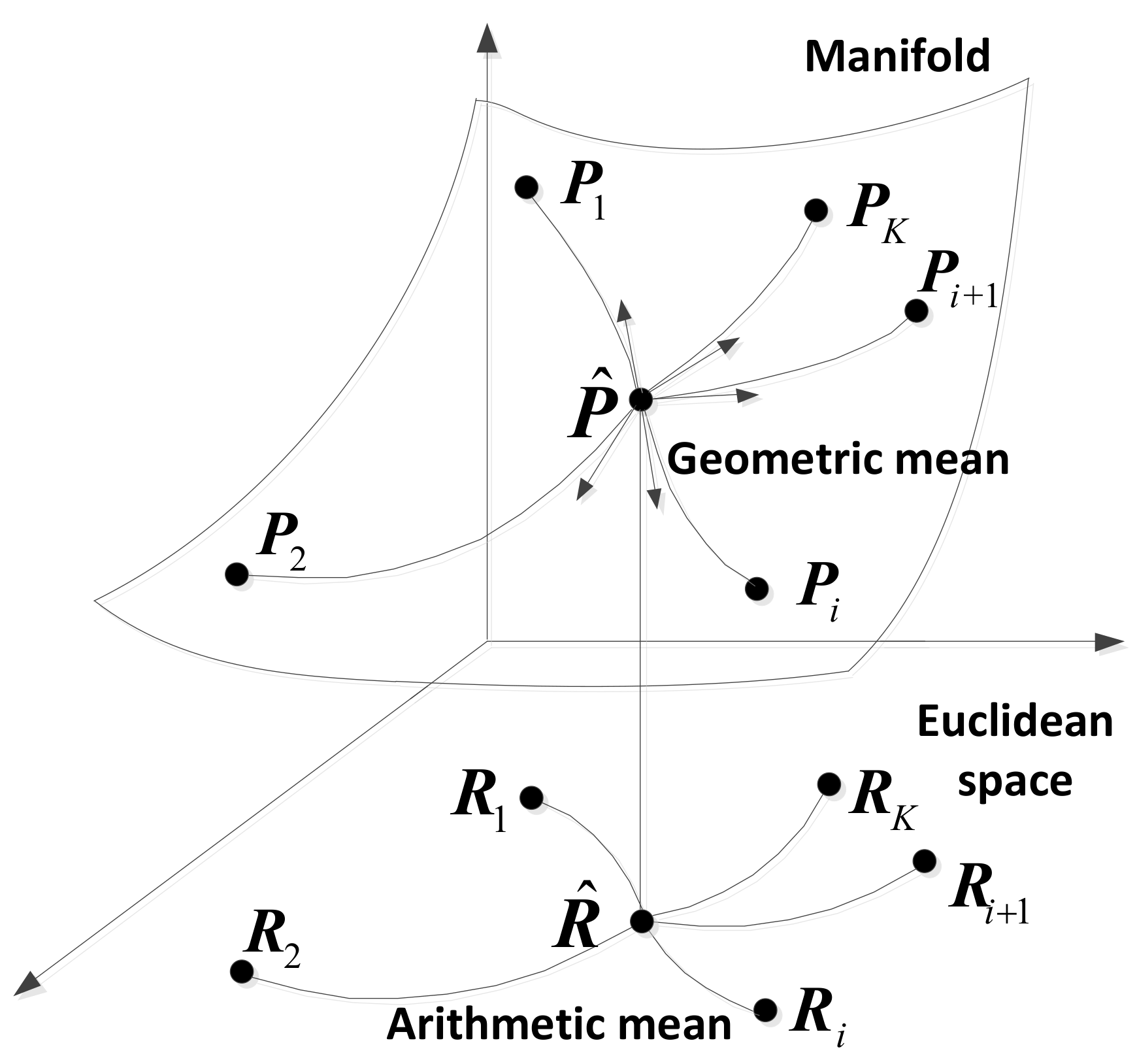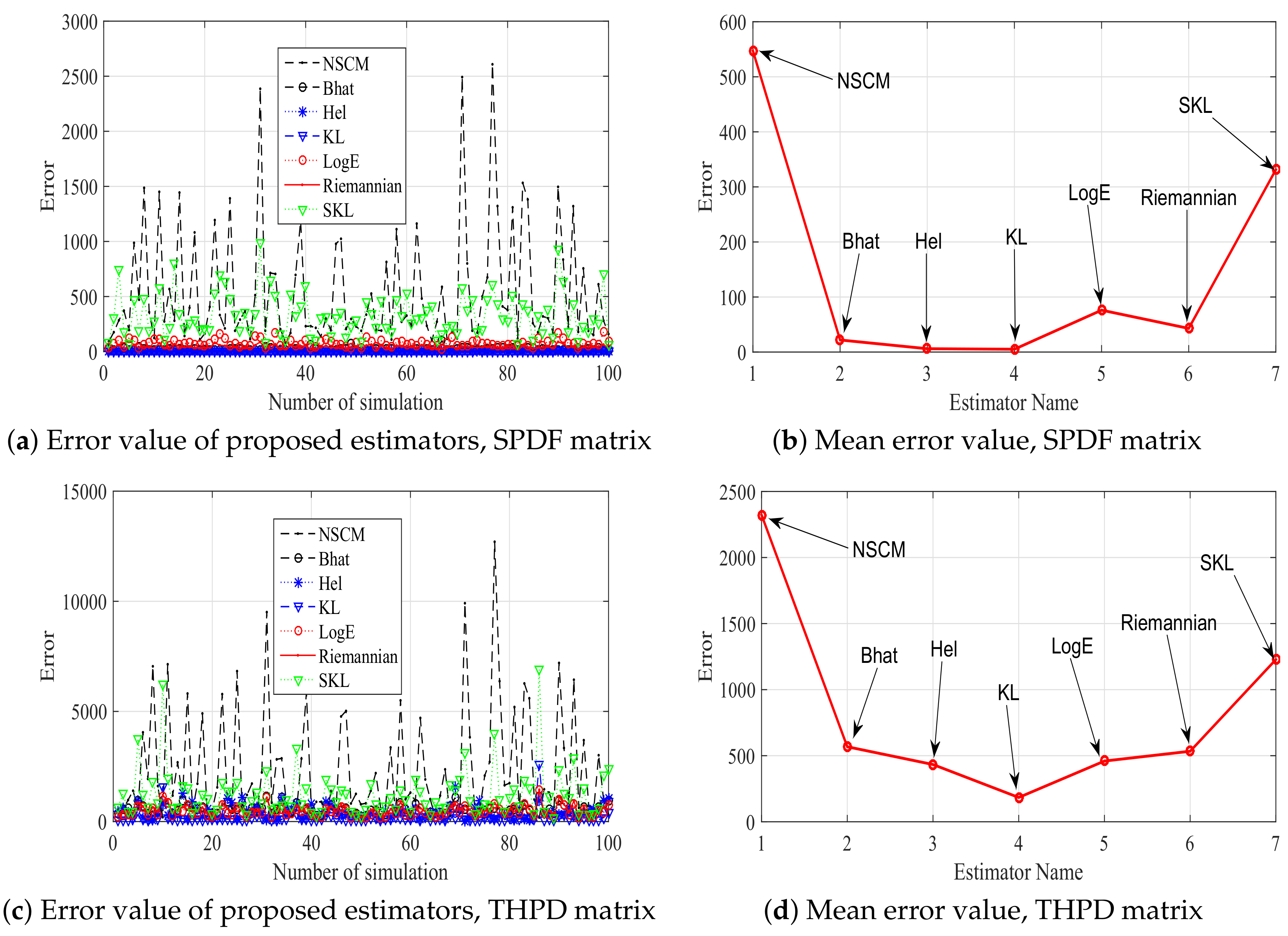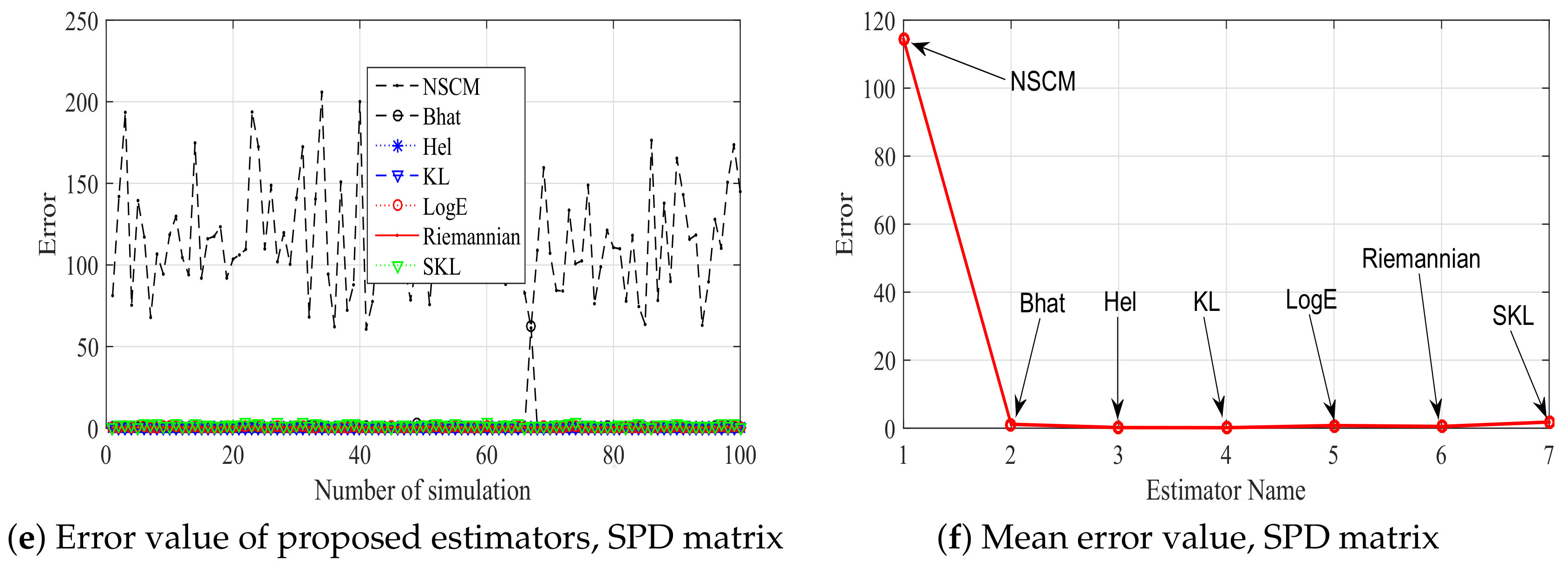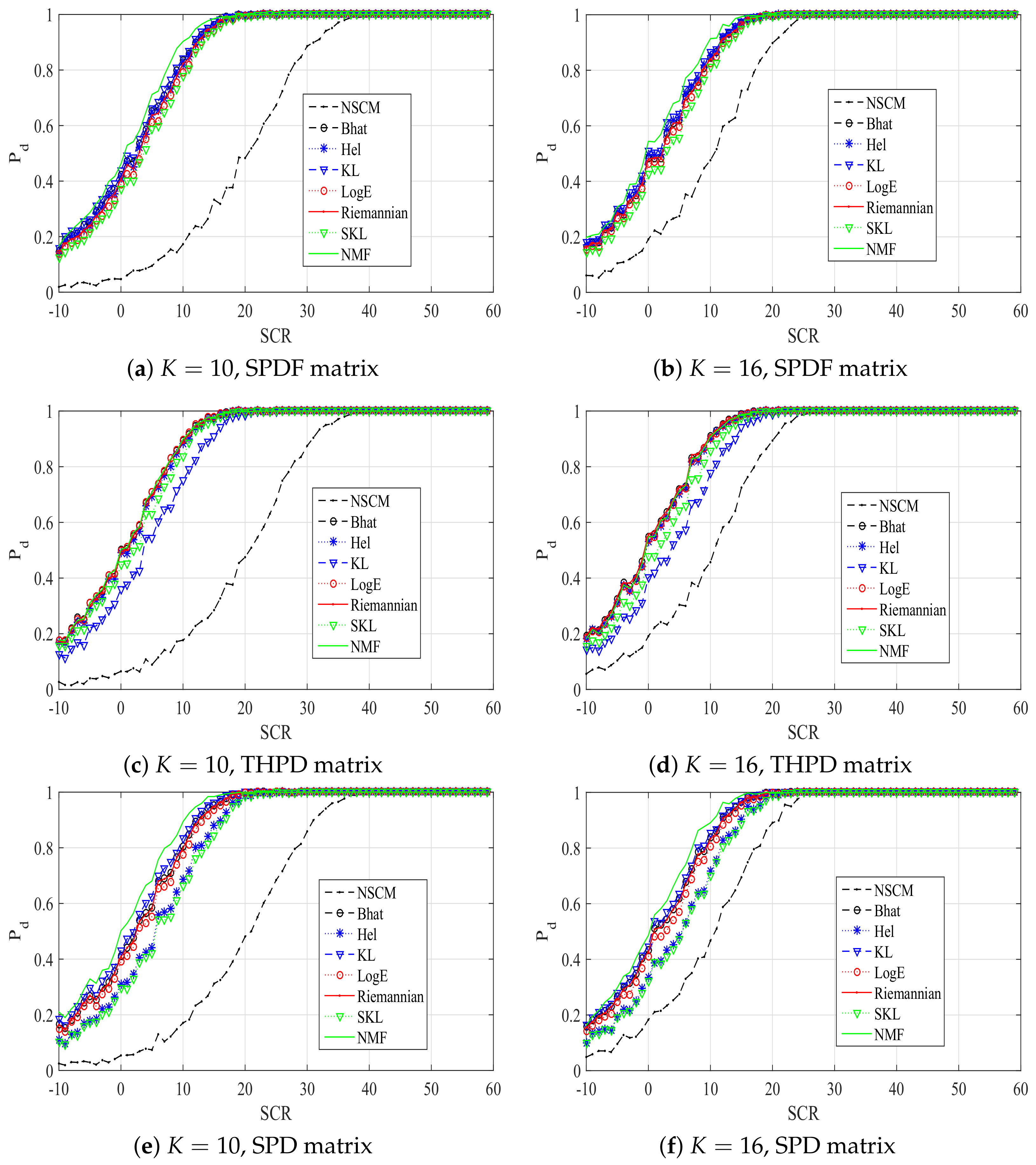Robust Covariance Estimators Based on Information Divergences and Riemannian Manifold
Abstract
:1. Introduction
Notation
2. Problem Reformulated on the Riemannian Manifold
- (1) is obtained by adding an identity matrix , as ;
- (2) A Toeplitz HPD matrix is utilized. As in [13], can be expressed as,where denotes the correlation coefficient of sample data, and is the complex conjugate of . can be computed as,
- (3) The HPD matrix is the solution of the optimization problem as follows [17],
3. The Geometry of Riemannian Manifold of HPD Matrices
3.1. The Riemannian Manifold of HPD Matrices
3.2. The Geometric Measure on the Riemannian Manifold
3.3. The Geometric Mean for A Set of HPD Matrices
4. Robustness Analysis of Geometric Means
5. Numerical Simulations
6. Conclusions
Acknowledgments
Author Contributions
Conflicts of Interest
References
- Visuri, S.; Oja, H.; Koivunen, V. Multichannel signal processing using spatial rank covariance matrices. In Proceedings of the IEEE Eurasip Workshop on Nonlinear Signal and Image Processing, Antalya, Turkey, 20–23 June 1999; pp. 75–79. [Google Scholar]
- Williams, D.B.; Johnson, D.H. Robust estimation of structured covariance matrices. IEEE Trans. Signal Process. 1993, 41, 2891–2906. [Google Scholar] [CrossRef]
- Barton, T.; Smith, S. Structured Covariance Estimation for Space-Time Adaptive Processing. In Proceedings of the IEEE International Conference on Acoustics, Speech, and Signal Processing, Munich, Germany, 21–24 April 1997; pp. 3493–3496. [Google Scholar]
- Semeniaka, A.V.; Lekhovitskiy, D.I.; Rachkov, D.S. Comparative analysis of Toeplitz covariance matrix estimation methods for space-time adaptive signal processing. In Proceedings of the IEEE CIE International Conference on Radar, Chengdu, China, 24–27 October 2011; pp. 696–699. [Google Scholar]
- Maio, A.D.; Farina, A.; Foglia, G. Design and experimental validation of knowledge-based constant false alarm rate detectors. IET Radar Sonar Navig. 2007, 1, 308–316. [Google Scholar] [CrossRef]
- Maio, A.D.; Farina, A.; Foglia, G. Knowledge-Aided Bayesian Radar Detectors Their Application to Live Data. IEEE Trans. Aerosp. Electron. Syst. 2010, 46, 170–183. [Google Scholar] [CrossRef]
- Wang, P.; Li, H.; Himed, B. Knowledge-Aided Parametric Tests for Multichannel Adaptive Signal Detection. IEEE Trans. Signal Process. 2011, 59, 5970–5982. [Google Scholar] [CrossRef]
- Li, H.; Michels, J.H. Parametric adaptive signal detection for hyperspectral imaging. IEEE Trans. Signal Process. 2006, 54, 2704–2715. [Google Scholar]
- Aubry, A.; Maio, A.D.; Pallotta, L.; Farina, A. Maximum Likelihood Estimation of a Structured Covariance Matrix with a Condition Number Constraint. IEEE Trans. Signal Process. 2012, 60, 3004–3021. [Google Scholar] [CrossRef]
- Maio, A.D.; Orlando, D.; Foglia, G.; Foglia, G. Adaptive Detection of Point-Like Targets in Spectrally Symmetric Interference. IEEE Trans. Signal Process. 2016, 64, 3207–3220. [Google Scholar] [CrossRef]
- Liu, Z.; Barbaresco, F. Doppler Information Geometry for Wake Turbulence Monitoring; Springer: Berlin/Heidelberg, Germany, 2013. [Google Scholar]
- Barbaresco, F.; Meier, U. Radar monitoring of a wake vortex: Electromagnetic reflection of wake turbulence in clear air. C. R. Phys. 2010, 11, 54–67. [Google Scholar] [CrossRef]
- Lapuyade-Lahorgue, J.; Barbaresco, F. Radar detection using Siegel distance between autoregressive processes, application to HF and X-band radar. In Proceedings of the IEEE Radar Conference, Rome, Italy, 26–30 May 2008; pp. 1–6. [Google Scholar]
- Balaji, B.; Barbaresco, F. Application of Riemannian mean of covariance matrices to space-time adaptive processing. In Proceedings of the IEEE Radar Conference, Amsterdam, The Netherlands, 31 October–2 November 2012; pp. 50–53. [Google Scholar]
- Balaji, B. Riemannian mean and space-time adaptive processing using projection and inversion algorithms. Proc. SPIE 2013, 8714, 813–831. [Google Scholar]
- Barbaresco, F. Robust statistical Radar Processing in Frechet metric space: OS-HDR-CFAR and OS-STAP Processing in Siegel homogeneous bounded domains. In Proceedings of the International Radar Symposium (IRS), Leipzig, Germany, 7–9 September 2011; pp. 639–644. [Google Scholar]
- Aubry, A.; Maio, A.D.; Pallotta, L.; Farina, A. Covariance matrix estimation via geometric barycenters and its application to radar training data selection. IET Radar Sonar Navig. 2013, 7, 600–614. [Google Scholar] [CrossRef]
- Aubry, A.; Maio, A.D.; Pallotta, L.; Farina, A. Median matrices and their application to radar training data selection. IET Radar Sonar Navig. 2013, 8, 265–274. [Google Scholar] [CrossRef]
- Hua, X.; Cheng, Y.; Wang, H.; Qin, Y.; Li, Y. Geometric means and medians with applications to target detection. IET Signal Process. 2017, 11, 711–720. [Google Scholar] [CrossRef]
- Hua, X.; Cheng, Y.; Wang, H.; Qin, Y.; Li, Y.; Zhang, W. Matrix CFAR detectors based on symmetrized Kullback Leibler and total Kullback Leibler divergences. Digit. Signal Process. 2017, 69, 106–116. [Google Scholar] [CrossRef]
- Hua, X.; Cheng, Y.; Li, Y.; Shi, Y.; Wang, H.; Qin, Y. Target Detection in Sea Clutter via Weighted Averaging Filter on the Riemannian Manifold. Aerosp. Sci. Technol. 2017, 70. [Google Scholar] [CrossRef]
- Charfi, M.; Chebbi, Z.; Moakher, M.; Vemuri, B.C. Using the Bhattacharyya Mean for the Filtering and Clustering of Positive-Definite Matrices. In Proceedings of the Geometric Science of Information: First International Conference, GSI 2013, Paris, France, 28–30 August 2013; pp. 551–558. [Google Scholar]
- Charfi, M.; Chebbi, Z.; Moakher, M.; Vemuri, B.C. Bhattacharyya median of symmetric positive-definite matrices and application to the denoising of diffusion-tensor fields. In Proceedings of the IEEE International Symposium on Biomedical Imaging, San Francisco, CA, USA, 7–11 April 2013; pp. 1227–1230. [Google Scholar]
- Jayasumana, S.; Hartley, R.; Salzmann, M.; Li, H.; Harandi, M. Kernel Methods on the Riemannian Manifold of Symmetric Positive Definite Matrices. Comput. Vis. Pattern Recog. 2013, 73–80. [Google Scholar]
- Hiai, F.; Petz, D. Riemannian metrics on positive definite matrices related to means. Linear Algebra Appl. 2008, 430, 3105–3130. [Google Scholar] [CrossRef]
- Sra, S. Positive definite matrices and the S divergence. Proc. Am. Math. Soc. 2011, 144, 1–25. [Google Scholar] [CrossRef]
- Moakher, M. On the Averaging of Symmetric Positive Definite Tensors. J. Elast. 2006, 82, 273–296. [Google Scholar] [CrossRef]
- Lang, S. Fundamentals of differential geometry. In Graduate Texts in Mathematics; Springer: New York, NY, USA, 1946; pp. 1757–1764. [Google Scholar]
- Moakher, M. A Differential Geometric Approach to the Geometric Mean of Symmetric Positive-Definite Matrices. Siam J. Matrix Anal. Appl. 2008, 26, 735–747. [Google Scholar] [CrossRef]
- Arsigny, V.; Fillard, P.; Pennec, X.; Ayache, N. Log-Euclidean metrics for fast and simple calculus on diffusion tensors. Magn. Reson. Med. 2006, 56, 411–421. [Google Scholar] [CrossRef] [PubMed]
- Lindsay, B.G. Efficiency Versus Robustness: The Case for Minimum Hellinger Distance and Related Methods. Ann. Stat. 1994, 22, 1081–1114. [Google Scholar] [CrossRef]
- Csiszar, I. Why Least Squares and Maximum Entropy? An Axiomatic Approach to Inference for Linear Inverse Problems. Ann. Stat. 1991, 19, 2032–2066. [Google Scholar] [CrossRef]
- Menendez, M.L.; Pardo, J.A.; Pardo, L.; Pardo, M.C. The Jensen-Shannon divergence. J. Frankl. Inst. 1997, 334, 307–318. [Google Scholar] [CrossRef]
- Fishman, G.S. Monte Carlo. Concepts, algorithms, and applications. Technometrics 1996, 39, 338. [Google Scholar]
- Klein, S.R.; Nystrand, J.; Seger, J.; Gorbunov, Y.; Butterworth, J. STARlight: A Monte Carlo simulation program for ultra peripheral collisions of relativistic ions. Comput. Phys. Commun. 2016, 212, 258–268. [Google Scholar] [CrossRef]
- Pask, F.; Lake, P.; Yang, A.; Tokos, H.; Sadhukhan, J. Sustainability indicators for industrial ovens and assessment using Fuzzy set theory and Monte Carlo simulation. J. Clean. Prod. 2016, 140, 1217–1225. [Google Scholar] [CrossRef]
- Ma, Y.; Chen, X.; Biegler, L.T. Monte Carlo simulation-based optimization for copolymerization processes with embedded chemical composition distribution. Comput. Chem. Eng. 2018, 109, 261–275. [Google Scholar] [CrossRef]
- Vilcu, A.D.; Vilcu, G.E. An algorithm to estimate the vertices of a tetrahedron from uniform random points inside. Ann. Mat. Pura Appl. 2016, 4, 1–14. [Google Scholar] [CrossRef]
- Bormetti, G.; Callegaro, G.; Livieri, G.; Pallavicini, A. A backward Monte Carlo approach to exotic option pricing. Eur. J. Appl. Math. 2018, 29, 146–187. [Google Scholar] [CrossRef]
- Conte, E.; Lops, M.; Ricci, G. Adaptive detection schemes in compound-Gaussian clutter. IEEE Trans. Aerosp. Electron. Syst. 1998, 34, 1058–1069. [Google Scholar] [CrossRef]





| Geometric Measure | Mean |
|---|---|
| Riemannian | |
| Log-Euclidean | |
| Hellinger | |
| KL | |
| Bhattacharyya | |
| SKL |
© 2018 by the authors. Licensee MDPI, Basel, Switzerland. This article is an open access article distributed under the terms and conditions of the Creative Commons Attribution (CC BY) license (http://creativecommons.org/licenses/by/4.0/).
Share and Cite
Hua, X.; Cheng, Y.; Wang, H.; Qin, Y. Robust Covariance Estimators Based on Information Divergences and Riemannian Manifold. Entropy 2018, 20, 219. https://doi.org/10.3390/e20040219
Hua X, Cheng Y, Wang H, Qin Y. Robust Covariance Estimators Based on Information Divergences and Riemannian Manifold. Entropy. 2018; 20(4):219. https://doi.org/10.3390/e20040219
Chicago/Turabian StyleHua, Xiaoqiang, Yongqiang Cheng, Hongqiang Wang, and Yuliang Qin. 2018. "Robust Covariance Estimators Based on Information Divergences and Riemannian Manifold" Entropy 20, no. 4: 219. https://doi.org/10.3390/e20040219





